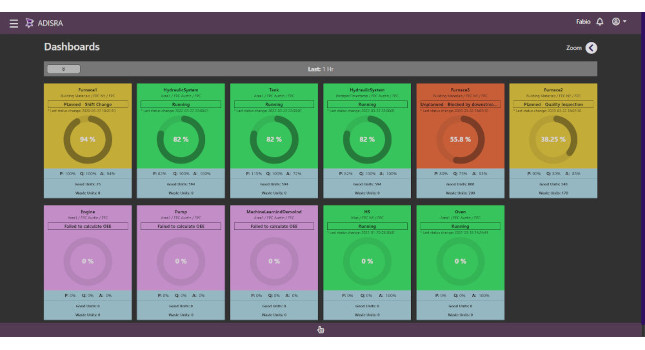Building on analytics foundations to improve operations
Advanced data acquisition methods enable the newest generation of operational analytics.
Analytics insights
- Analytics are going to be a key driver for manufacturers looking to get the most productivity and insight from their operations as they deal with supply chain and labor shortages. It’s not enough to have analytics, though. It has to supplement data acquisition to provide real value for manufacturers.
- Technologies like OPC UA and message queuing telemetry transport (MQTT) have come along in recent years to help augment analytics and data acquisition on the manufacturing floor. These, along with other technologies, help industrial plants and facilities improve operations by providing access to real-time manufacturing data.
As industrial manufacturing faces numerous challenges like labor shortages, material scarcity, and increasing material costs, the access to accurate production data is essential for monitoring production operations, optimizing manufacturing efficiency, and preventing downtime. The famous statistician Edward Deming once said, “Without [factual understandable] data you’re just another person with an opinion.”
Technology innovations in the industrial automation arena have and will continue to create competitive advantages for manufacturers by enabling the accurate and understandable data acquisition that is key to driving manufacturing efficiency. This article examines some of the progress over the years, and how analytics must supplement data acquisition to provide value.
Industrial communication evolution
Programmable logic controllers (PLCs) were developed in the late 1960s. PLCs were a significant improvement over hard-wired relay logic, providing easy automation logic control changes and leading to the rapid adoption of digital technology in discrete and process automation manufacturing.
Microprocessor-based PLCs provided a wealth of data from plant floor sensors, switches, actuators, and much more internally-derived information. However, early communication media and protocols were limited in speed and capability, and only reported on request using a client/server method, so they could not report exceptions.
Ruggedized industrial PCs (IPCs), suitable for plant floor use, were introduced in the mid-1980s, providing the ability to host supervisory control and data acquisition (SCADA) applications, and human-machine interface (HMI) devices were introduced in the early 1990s. IPCs, SCADA, and HMIs allowed plant floor operators to visualize a production machine and make changes to operational settings.
Historically, most industrial communication protocols used for PLCs, IPCs, and HMIs were developed by or with help from PLC vendors, such as:
- Modbus by Modicon (now Schneider Electric).
- Profibus by Siemens.
- DF1 serial by Rockwell Automation.
- Many others by Siemens, Omron, Mitsubishi and more.
Ethernet, tag names, improved communications
Some of these were proprietary and some were not, but the wide assortment made it difficult for end users to achieve complete connectivity. As IT technology was improving, the operational technology (OT) world began moving away from proprietary methods and trending toward a more open IT approach.
For example, Ethernet began to be used on the plant floor in the 1990s even though many communication protocols were not interoperable. Notable examples of protocols updated to Ethernet include Modbus TCP, EtherNet/IP and Profinet.
As new Ethernet protocols were developed, a second trend was the use of “tag names” instead of register names, providing easier association of the PLC register being used and its programming function.
A third trend in the evolution was efforts to improve communications among different applications. OPC DA (OPC Data Access) was first introduced in 1995. OPC is the shortened name for OLE (object linking and embedding) for Process Control, which was based on Microsoft Windows COM (component object model) technology. OPC DA was based on a client/server architecture, and it allowed sharing real-time data with its basic attributes between different applications, without each application knowing the interface details of the other.
Several companies developed OPC DA server products, allowing HMI/SCADA products and other applications to access PLCs using various industrial Ethernet protocols. These solutions allowed users to easily interface with PLCs without developing a specific communications driver each time. While OPC DA was a significant improvement in communications technology for PLC data acquisition at the time, it had limitations such as:
- Minimal security.
- No platform independence (Microsoft Windows only).
- Performance constraints.
- Architecture not optimized for the internet.
- Limited data type handling.
OPC UA and MQTT
To address these and other issues, OPC UA (OPC Unified Architecture) was released in 2008. OPC UA is a platform-independent solution which can run many platforms, including an embedded microcontroller device using Linux, Apple and Android devices, Microsoft Windows-based IPCs, a cloud-based infrastructure and others. Key features include:
- Encrypted communications, with user authentication and activity logging.
- Support for transport protocols like OPC-binary or JSON over WebSockets.
- Sequenced packets to defend against replay attacks.
- Publish/subscribe (pub/sub) capability.
Pub/sub is of particular interest compared to the traditional client/server mechanism, because it allows edge devices like PLCs and sensors to send fresh data to a message-oriented middleware server which in turn can supply the data to any number of subscribers, such as an HMI/SCADA application.
While OPC UA is a powerful architecture to move data from edge devices to consumers, some concerns over the complexity of OPC UA have resulted in the development of other technologies. A good example is message queuing telemetry transport (MQTT), which is a lightweight pub/sub protocol designed to transport data between end point devices and higher-layer software.
MQTT was developed in 1999 to connect remote oil pipelines with centralized SCADA, typically over low-bandwidth satellite links. It is important to note MQTT’s architecture is very flexible due to the use of “clients” which supply data to a “broker,” which can provide the data to any “clients” that request it. There is no hard linkage between publishers and subscribers in this model, which streamlines operation and support.
Data acquisition leading to IoT
The many data acquisition methods have eased implementation of Internet of Things (IoT) projects. For industrial and mission-critical applications such as the monitoring of machines, gas pipelines, and transportation grids, the term is often modified to Industrial IoT (IIoT).
IoT implementations allow an edge (end point) device to connect via an IoT gateway service to a host device, allowing access to information contained in the edge device.
A second conceptual model of this trend is called Industry 4.0, popularized in 2015 by the World Economic Forum. This model represents a fundamental shift, introducing artificial intelligence (AI), analytics and advanced robotics into traditional manufacturing. IIoT plays an important part of Industry 4.0 because it provides efficient mechanisms for passing data from edge devices, such as sensors and machines, to higher-level monitoring, computing and analysis performed by humans and AI. As a result, OPC UA and MQTT technologies are key to implementing IIoT and Industry 4.0.
With modern PLC technology, data sampling rates in the sub-millisecond range is now possible. Data updates rates in the 10-ms range can be achieved using an OPC UA server. Communication rates using direct PLC protocol drivers, like Modbus TCP or EtherNet/IP, for connectivity between the HMI/SCADA system and the PLC can occur in the 10 to 30 ms range, depending on the amount of data being communicated. These increased speeds allow responsive monitoring of production and machine data.
Applying data acquisition to improve operations
All these developments help industrial plants and facilities improve operations by providing access to real-time manufacturing data. This gives them the ability to make better data-driven decisions by optimizing production performance and minimizing downtime.
Some metrics and tools have been developed for using this real-time production data to help optimize manufacturing efficiency. Overall equipment effectiveness (OEE) monitors production results against production goals while predictive analytics detect impending equipment failures.
OEE is a tool used to monitor current manufacturing operations compared to its full potential. An OEE of 100% means only good parts are made at full operational speed with no production line stoppage. OEE is used as a metric for manufacturing productivity, calculated as follows:
OEE = A * P * Q
Where A equals the % of time the equipment or production line is running; P equals the % of speed/throughput performance; and Q defines the % for quality of the parts produced (Figures 1 and 2).

Figure 1: Adisra SmartView and InsightView put data acquisition into action, allowing users to easily create informative OEE displays and dashboards. Courtesy: Adisra

Figure 2: OEE reports are essential tools to help operators understand and improve manufacturing performance. Courtesy: Adisra
Four types of analytics
Analytics is the use of production data to help users make decisions about production operations. There are four primary analytics categories, and each is a distinct tool for improving operations:
- Descriptive analytics.
- Diagnostic analytics.
- Predictive analytics.
- Prescriptive analytics.
Descriptive analytics is historically the most used analytics tool, and it looks at past production data to determine what happened and what caused problems. Based on real-time and past data, it garners insights on how the process is performing by providing context to the data. This is more of a “post-mortem” type of analysis.
Diagnostic analytics uses statistics to find patterns, offering insights into the real-time data. Root cause analysis is one of the most popular methodologies. Diagnostic analytics answers the question of “Why did this happen?”, and it too is a “post-mortem” type of analysis.
Predictive analytics are a set of tools for providing answers about what is likely to happen, based on current operational status. Predictive analytics depends upon real-time data from the production process, and uses tools such as statistical analysis, regression, and artificial intelligence to analyze past manufacturing data and predict the near future of manufacturing operations. Predictive analytics are often cloud-hosted to allow easy acquisition from multiple data sources, along with the storage/retrieval of data required for predictive analytics tools to operate effectively.
Prescriptive analytics are analytical tools that predict not only what will happen, but also when and why it will happen, with advice provided to mitigate risk. These tools require access to both real-time and historical data sources. Oil production operations, for example, would use prescriptive analytics on oilfield equipment to help optimize production output and minimize downtime.

Figure 3: By analyzing past data, AdisraInsightView seeks to predict the near future of operations, and can detect the remaining useful lifetime of assets. Courtesy: Adisra
Data acquisition supports valuable analytics
Data acquisition is a fundamental element for supporting visualization and analytics, which are necessary to drive manufacturing efficiency. Without easy access to high-speed real-time data, it is impractical to implement solutions such as OEE and predictive analytics. Because good data acquisition options are available and have been trending to be more open and usable, modern software tools for visualization and analytics have been developed to provide improved functionality and ease of deployment. These software tools will continue to grow and are helping companies achieve their production goals for manufacturing operations.
Original content can be found at Control Engineering.
Do you have experience and expertise with the topics mentioned in this content? You should consider contributing to our CFE Media editorial team and getting the recognition you and your company deserve. Click here to start this process.





